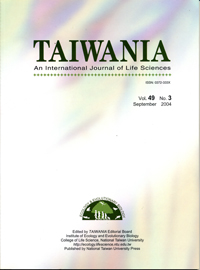Research Paper
Habitat Use of Two Benthic Fishes, Crossostoma lacustre and Rhinogobius candidianus, in the Happen Creek of Northern Taiwan
Ling-Chuan Chuang, Shih-Hsiung Liang and Yao-Sung Lin
Published on: September 2004
Page: 166 - 174
DOI: 10.6165/tai.2004.49(3).166
Abstract
Habitat use was investigated for two common endemic and benthic fishes, Crossostoma lacustre and Rhinogobius candidianus, in the Hapen Creek of northern Taiwan from August 1996 to December 1998. C. lacustre and R. candidianus overlapped in mesohabitat use; both fish species preferred riffles to pools. Further analyses based on stepwise multiple regression showed that fish density was significantly correlated with water depth, small boulder, and finer substrate for C. lacustre, but correlated with water depth, stream width, large boulder, and cobble for R. candidianus. The separation in the microhabitat use might have alleviated the pressure for interspecific competitions despite of their overlapping in the mesohabitat scale. Parallelly, the result suggests that the diverse substratum composition may have accounted for the co-exsitence of these two benthic fishes. It would also provide valuable information for habitat management and ecological engineering of mountain creeks in Taiwan.
中文摘要
自1996 年8 月至1998 年12 月於台灣北部的哈盆溪流域進行台灣纓口鰍(Crossostoma lacustre) 及明潭吻鰕虎 (Rhinogobius candidianus) 兩種底棲性魚類棲地利用的研究。結果顯示台灣纓口鰍與明潭吻鰕虎在中型棲地 (mesohabitat) 尺度的利用上有重疊現象,而且都比較偏好水淺的急流 (riffle)。經進一步以逐步複迴歸分析法 (stepwise multiple regression analysis) 分析微棲地 (microhabitat) 的利用,發現台灣纓口鰍的魚群密度與水深、小巨石 (small boulder)、細沙與小礫石 (sand and gravel) 有顯著的關係;而明潭吻鰕虎則與水深、溪寬、大巨石 (large boulder)、卵石 (cobble) 有顯著相關。雖然台灣纓口鰍與明潭吻鰕虎在中型棲地的利用上有重疊,但是微棲地利用上的區隔可能降低種間競爭的壓力。根據本研究結果,維持底石 (substrate) 的多樣化應有利於這兩底棲魚種的共存,同時對於台灣溪流在棲地經營與生態工法的施行上,也能提供具有價值的相關資訊。
Keyword: Crossostoma lacustre, Rhinogobius candidianus, Riffle, Pool, Taiwan


